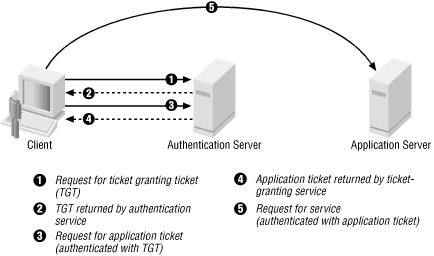Understanding Kerberos concepts¶
Kerberos Version 5 is a standard on all versions of Windows 2000 and ensures the highest level of security to network resources. The Kerberos protocol name is based on the three-headed dog figure from Greek mythology known as Kerberos. The three heads of Kerberos comprise the Key Distribution Center (KDC), the client user and the server with the desired service to access. The KDC is installed as part of the domain controller and performs two service functions:
- the Authentication Service (AS) and
- the Ticket-Granting Service (TGS).

Three exchanges are involved when the client initially access a server resource: AS exchange (circles 1 and 2), TGS exchange (circles 3 and 4) and finally a client/server exchange (request shown as circle 5).
AS exchange¶
When initially logging on to a network, users must negotiate access by providing a login name and password in order to
be verified by the AS portion of a KDC. The KDC has access to Active Directory user account information. Once
successfully authenticated, the user is granted a Ticket to Get Tickets (TGT) that is valid for the local domain (in our
example, for the realm example.com). The TGT has a default lifetime of 10 hours and may be renewed throughout the
user’s log-on session without requiring the user to re-enter her password.
If the KDC approves the client’s request for a TGT, the reply (referred to as the AS reply) will include two sections: a TGT encrypted with a key that only the KDC (TGS) can decrypt and a session key encrypted with the user’s password hash to handle future communications with the KDC. Because the client system cannot read the TGT contents, it must blindly present the ticket to the TGS for service tickets. The TGT includes time to live parameters, authorization data, a session key to use when communicating with the client and the client’s name.
TGS exchange¶
The user presents the TGT to the TGS portion of the KDC when desiring access to a server service. The TGS on the KDC authenticates the user’s TGT and creates a ticket and session key for both the client and the remote server. This information, known as the service ticket, is then cached locally on the client machine.
The TGS receives the client’s TGT and reads it using its own key. If the TGS approves of the client’s request, a service ticket is generated for both the client and the target server. The client reads its portion using the TGS session key retrieved earlier from the AS reply. The client presents the server portion of the TGS reply to the target server in the client/server exchange coming next.
Client/server exchange¶
Once the client user has the client/server service ticket, he can establish the session with the server service. The server can decrypt the information coming indirectly from the TGS using its own long-term key with the KDC. The service ticket is then used to authenticate the client user and establish a service session between the server and client. After the ticket’s lifetime is exceeded, the service ticket must be renewed to use the service.
